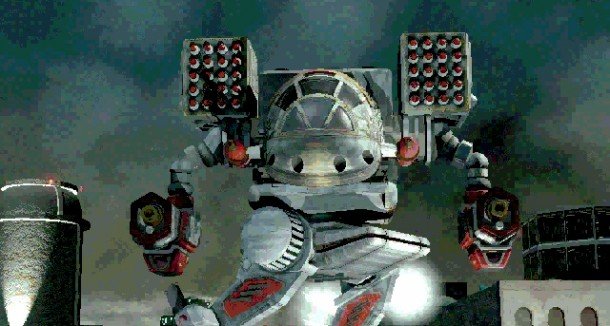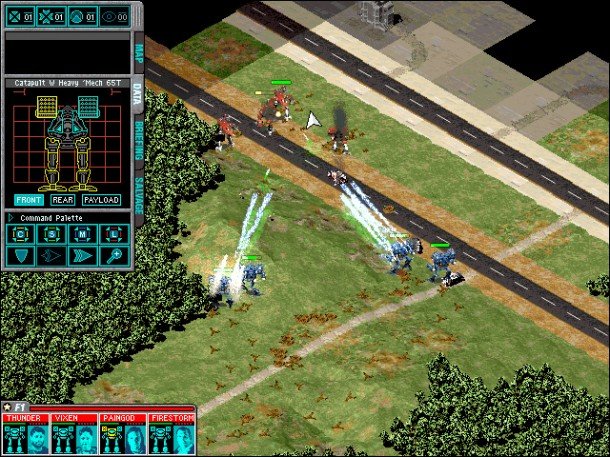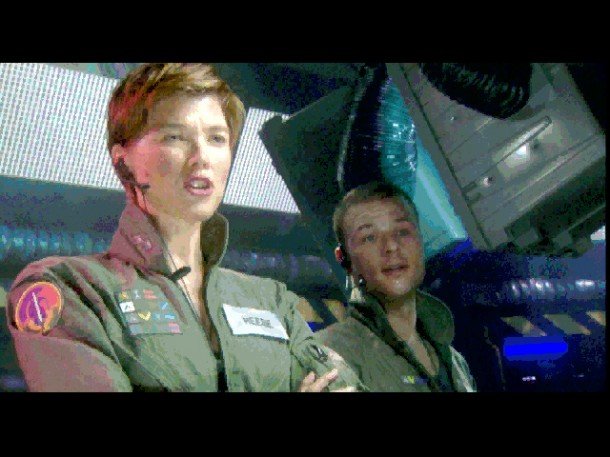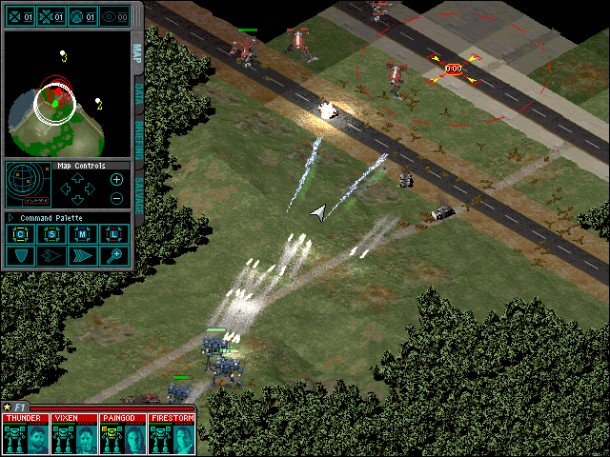Reinstall: MechCommander

Time to roll the dice. I'm replaying the third mission of MechCommander, a few giant robot steps away from a big moment: my first run-in with a MadCat. If I play things right, I can bag it. One problem: I'm totally outmatched. My four-man rookie squad is piloting wiry light mechs (Commandos and Firestarters); essentially, I'm about to send a gaggle of Geo Metros against a Ferrari.
The MadCat's iconic frame emerges from the fog of war, its egg-shaped cockpit perched atop raptor legs, shouldering twin blocks of long-range missile racks. I've got to make a call: do I sprint to the extraction point and attempt to complete the mission without a fight? Do I use the nuclear option and zap the rows of gas tanks near the MadCat for a sure kill—but with no chance of salvaging it? Or do I fight it head-on, and maybe—if I range correctly, kite it away from my damaged scout mech, and find enough finesse—knock the beast down without killing it, adding it to my squad and taking it into mission four as a playable prize?

Custom-built
MechCommander is magic—for me, it's the purest expression of everything anyone ever loved (having a garage filled with multi-story death robots and lasers) about FASA Interactive's more-famous versions of the series, MechWarrior, but packaged in a way that holds up better today than the decade-old iterations of its first-person brother.
You're a commander for an Inner Sphere force (BattleTech's good-guy rebellion), sent to win territory from the Clans so that the IS can establish a foothold on the verdant planet Port Arthur. Through escort, search-and-destroy and scouting missions, you field a team of up to 12 mechs, fostering pilots and equipment like precious action figures that run out of ammo, need to be repaired and can suffer permanent death. That ownership over your Mechs and pilots is at the core of the experience—taking a cue from Wing Commander, each pilot has a personality: an uncomfortably '90s callsign (“Paingod,” “Firestorm,” “Hitman”), unique voice and a charmingly low-res video that'd pop up whenever they spot an enemy.
True to the BattleTech name, at least a third of your time might be spent customizing. Tuning a medium-range, energy weapons-only Thor or piecing together a dual heavy-autocannon-wielding Atlas for short-range destruc-tion is a gratifying lull between battles. And though they were extremely fragile, the addition of single-use vehicles—including scout trucks, repair vehicles, missile tanks and minelayers—augmented your arsenal in a way that allowed for creative tactics, such as using a jumpjet-equipped Raven to sneak into a base and steal control of an enemy's turret control systems, then mining the doorstep.

Collect them all
Really, it's MC's salvage mechanic that drives everything important: every kill is an opportunity to add spare parts or a whole new walking tank to your inventory. The feeling of popping a mech, the sound of air being flushed and a five-pixel escape pod streaking up the screen, immediately keys loot lust— what'd I get ? Bringing home a salvaged chassis, PPC or LRM was instant cause to min-max and reallocate.
FASA did limit the complexity of what you could customize—heat is simplified (weapons fire on a cooldown timer) and you don't allocate heatsinks. And the game determines where weapons reside on your mech, not you. But the modular nature of mechs is meaningful where it counts: combat. Robot fights are wonderfully animated: a Vulture with a busted leg limps; missiling the arm off a Masakari removes its deadly PPCs; critical hits knock mechs flat on their back. And when you're on the receiving end of attacks, you find yourself in these “hangman” situations: if you lose the arm that held your prized autocannon, you'll have to rely on your remaining lasers or SRMs to finish the mission.
Keep up to date with the most important stories and the best deals, as picked by the PC Gamer team.
Warhammer 40,000: Dawn of War II was been lauded for applying loot and character progression to a real-time tactics template, but MechCommander laid a lot of the groundwork for that design almost a decade earlier. The game's 2.5D isometric visuals hold up better than any tactical game of the era, it ambitiously includes multiplayer for two to six players over Mplayer or LAN, and its expansion, Mech-Commander Gold, included an editor for creating standalone missions (or in my case: insane 10 Atlas vs. 10 MadCat battle royales).

MechCommander was my X-COM; it meaningfully splits your role as a player—you had to be an engineer and a tactican—oscillating between management and combat, returning to missions that you couldn't beat with creative loadouts. Atop all this, it's available for free after being released by Microsoft (the source code for the less-charming MechCommander 2 is available for grabs directly from Microsoft, too). Even at 640x480 resolution, the steady accumulation of robot parts makes it worth returning to.
On the second page: more MechCommander screenshots from our archive .

Evan's a hardcore FPS enthusiast who joined PC Gamer in 2008. After an era spent publishing reviews, news, and cover features, he now oversees editorial operations for PC Gamer worldwide, including setting policy, training, and editing stories written by the wider team. His most-played FPSes are CS:GO, Team Fortress 2, Team Fortress Classic, Rainbow Six Siege, and Arma 2. His first multiplayer FPS was Quake 2, played on serial LAN in his uncle's basement, the ideal conditions for instilling a lifelong fondness for fragging. Evan also leads production of the PC Gaming Show, the annual E3 showcase event dedicated to PC gaming.

